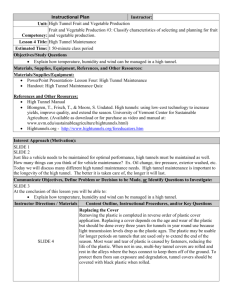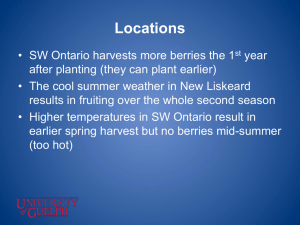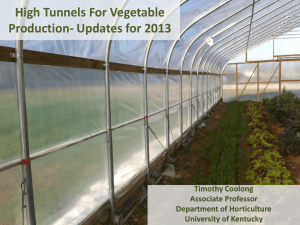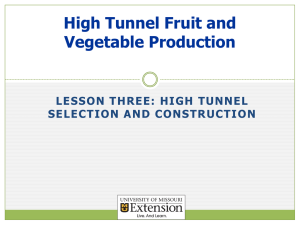PowerPoint - University of Missouri Extension
advertisement
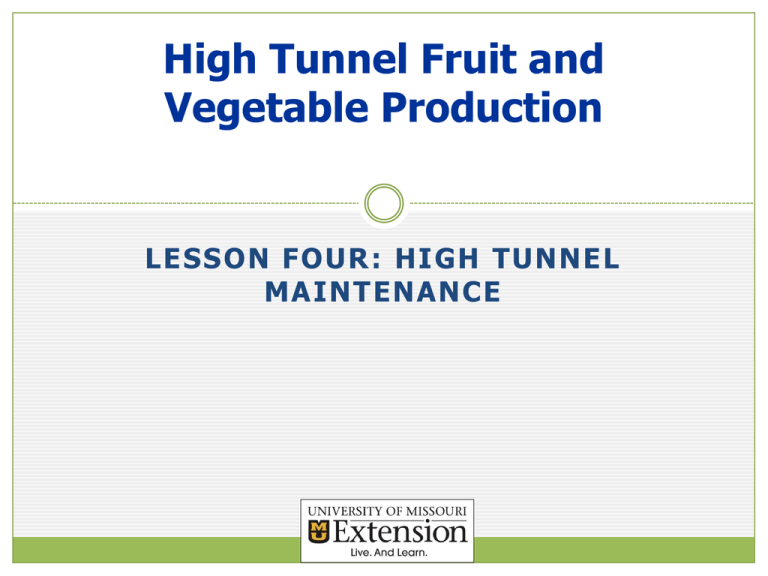
High Tunnel Fruit and Vegetable Production LESSON FOUR: HIGH TUNNEL MAINTENANCE Maintenance Just like a vehicle needs to be maintained for optimal performance, high tunnels must be maintained as well. How many things can you think of for vehicle maintenance? Today we will discuss many different high tunnel maintenance needs. Objective Explain how temperature, humidity and wind can be managed in a high tunnel. Replacing the Cover Remove the plastic in reverse order. Replacing a cover depends on the age and wear of the plastic, but should be done every three years for tunnels in year round use. When not in use, multi-bay tunnel covers are rolled and rest in the alleys where the bays connect to keep them off of the ground. To protect them from sun exposure and degradation, tunnel covers should be covered with black plastic when rolled. Regular Maintenance Plastic covers should be inspected regularly for wear and tear. Rips should be immediately repaired with clear tape. If the plastic remains on the tunnel for the winter, periodic removal of snow load may be needed to avoid structural weakening or collapse. This is best done with a non-pointed object, such as a long-handled floor broom head or squeegee, before ice or a stiff crust forms. Climate Variability The locations of plants in a high tunnel and the plant canopy have an effect on temperature variations. Some producers may expect high tunnels to extend the production season in the fall by protecting the crop from early frosts. However, the frost protection provided by the high tunnels is minimal. In many areas, high tunnels are most often used to facilitate early production rather than lateseason extension beyond the fall frost period. Temperature Variability Temperature High temperature can be as damaging to crops as low temperatures. Excessively high temperatures can cause flowers to fall off tomatoes and peppers as well as reduce pollination, resulting in a lower percentage of marketable fruit. Stress related to dehydration may be avoided through careful attention to availability of soil moisture. Shade cloth, and vents in the roof, end walls and side walls are the most effective ways to moderate temperature inside a high tunnel. Shade Cloth Shade cloth is used to reduce light intensity, temperature, and plant exposure to wind. In warm climates or during the summer, a shade cloth can be used as the sole covering for a high tunnel. Black, white and various shades of green and brown are available. Shade cloth is rated by the percent of light blocked, varying from 20 to 90 percent. Seasonal and crop species requirements dictate which percent shade cloth should be used. A 50 percent white or black shade cloth is commonly used. Humidity Careful ventilation will help to keep relative humidity at lower levels and to keep the foliage dry, preventing disease outbreaks. Proper use of drip irrigation will also keep the humidity low. High tunnel sides should be opened each morning to dry the leaves that have collected condensate during the night. Wind Trees, shrubs and fabricated material like wood lath can be used as a barrier to moderate and/or redirect wind. Windbreaks could consist of woody shrubs designed to be harvested for fruit or flowers. Windbreaks on the north side of a high tunnel should be about 100 feet away, keeping snow drifts away from the structure. The length of a windbreak should be ten times longer than it is high. Ventilation Regulate temperatures inside high tunnel by opening and closing tunnel sides, end doors and peak vents. Sides may be opened up fully or partially, depending on outside temperatures. Sides can remain open day & night during summer Retain as much heat as possible inside tunnel during night in spring and late fall Tunnel sides should be closed in late afternoon or sooner when outdoor temperatures cool off at night Activity Find a partner! You will be assigned a season: Spring, Summer, Fall or Winter. Describe a typical day for that season in regards to maintenance for the high tunnel. Try to come up with as many maintenance duties as possible. Present to the class. Summary Maintenance is an important aspect to proper utilization of the high tunnel. Without maintenance, the fruit and vegetable production could decrease or the high tunnel may fall into disrepair. A well maintained high tunnel will efficiently produce quality fruit and vegetables and therefore increase the yield and profit of produce.



